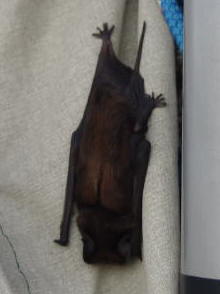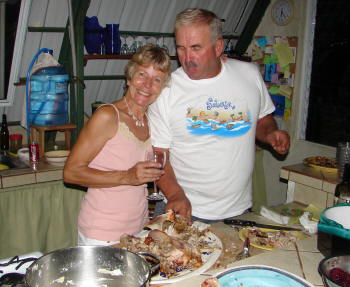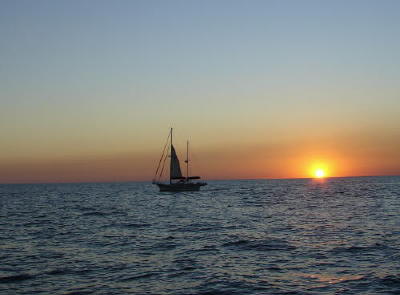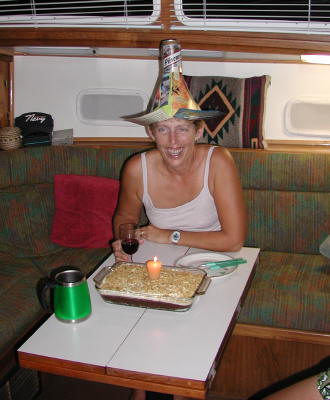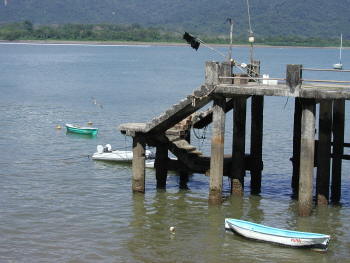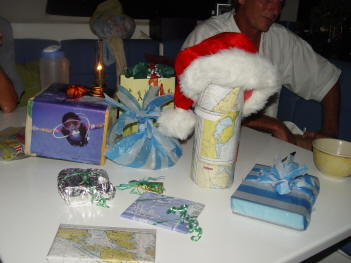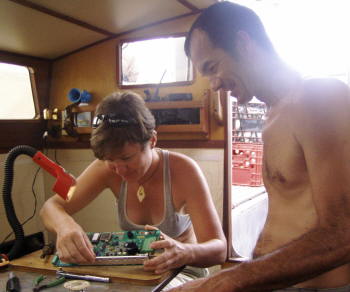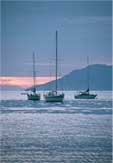
Logbook: October to December 2006
El Salvador & Costa Rica
After spending five weeks in the U.S. in September and October visiting family and friends, we returned to Slip Away in Bahia del Sol in late October and prepared to set sail again. It was hard to believe that six months had passed since we arrived here. We spent a month preparing to get underway (with a few diversions), departed at the end of November and spent the rest of 2006 cruising in Costa Rica.
|
Preparing to depart El Salvador (October & November) Slip Away had been moored in an estuary for six months, so there was lots to do to get her ready to leave. In addition to normal maintenance items like cleaning the bottom, changing the engine oil and checking water levels in the batteries, we needed to reinstall the headsail, staysail and some running rigging which we removed for the summer, as well as make a few repairs - troubleshooting a problem with our wind generator, replacing some wood slats on our bowsprit and attaching all the slats more securely, repairing a broken stanchion, varnishing and various other projects. (We really don't spend our days sipping rum drinks!) We did not remove our main and mizzen sails for the summer, and a family of five bats took up residence in our mainsail. Evicting them and then cleaning up all of their poop was not one of our favorite jobs! We also made a couple of trips into San Salvador - shopping trips to stock the boat with provisions for the next few months, and a visit to the dentist to have our teeth cleaned. (At $50 a cleaning, it's much cheaper than the States. Also, Rich liked having his teeth cleaned by Dra. Norma because she is very pretty and always greeted him with a kiss.) |
|
Bahia del Sol Marlin Tournament, November 9-11
| Before leaving El Salvador, we also had the opportunity to participate in an international fishing tournament. The second weekend in November, Hotel Bahia del Sol hosted their Annual Marlin and Billfish Tournament, which draws participants from all over Central America, and even a few folks from the U.S. Boats pay $1,000 US to enter the tournament, and the first prize is a car, so there is big money involved. A few years ago, they had a problem when they discovered that one of the participants tried to buy a winning fish. After that incident, the tournament sponsors decided they would put an "observer" on each boat to thwart future cheating attempts. The next year, they tried using bikini-clad girls as observers, but most of them got seasick and puked. The next year, they asked the folks on cruising boats to be the observers, and since we're used to being out on the ocean, that worked much better! Boats of all sizes enter this tournament, and when they asked us to be observers, they promised the ladies that they would be assigned to boats with nice bathrooms. Jan went out on a 39-foot Hatteras sport fisher with a flush toilet; Rich went on a 26-foot Wellcraft with a porta-pottie. |
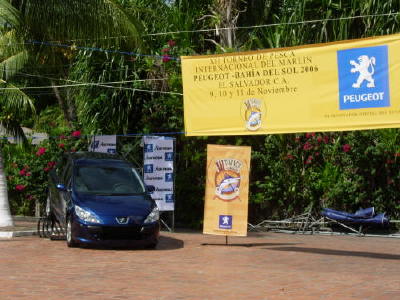 |
The kick-off party was on a Thursday night, and the fishing competition was on Friday and Saturday. We had to be up bright and early because the tournament boats departed the dock to start fishing at about 5:30 a.m.
Jan's boat was called "Show Time" and its hailing port was San Juan del Sur, Nicaragua. Show Time had four fishermen - Hugo, Mario, Ramiro and Enrique - and two crew, both named Joel. The Joel's did everything from bait hooks to mix drinks. All four of the fisherman were educated in the U.S. and spoke fluent English. They were extremely successful businessmen - newspaper, bank and commercial construction company owners - but they were incredibly nice and down-to-earth. They were complete gentlemen, but they liked to have a good time, and the Flor de Caña (Nicaraguan) rum flowed freely.
Rich's boat was called "Pitty" (named after the owner's wife), and it was from El Salvador. Pitty's owner is Mario Siman, and he owns the Siman Department Stores in Central America, Europe and the Mid-East. Mario brought his 9 year old son, Mario II, and a friend Carlos, who is a real estate developer with projects in El Salvador and Columbia. The second day a third friend, Geraldo, and his two boys joined us. A marinero named Fermin rounded out the crew on Pitty.
Show Time took 2nd place in the sailfish catch-and-release category. We caught, tagged and released five sailfish on Friday, and three on Saturday. We also caught three dorado and a wahoo - all good eating fish. We didn't catch any marlin. Pitty didn't win any trophies, but they caught, tagged and released two marlin and one sailfish on Friday. On Saturday, they only hooked one marlin, but he got away.
It was a great experience for us to participate in this tournament and meet such interesting people. Since the fisherman spoke better English than we speak Spanish, it was fascinating to be able to discuss politics, the economy and other relevant issues from the perspective of the local "movers-and-shakers".
|
Thanksgiving in El Salvador As Thanksgiving approached, we were finishing up our chores and looking at a departure date. We were tentatively planning to leave just before Thanksgiving, but we delayed those plans a few days because strong winds (called Papagallos) were forecast for the Nicaraguan coast. Colette & Murray, the American/Canadian couple who live in El Salvador and run a small marine business (they're the ones who watched over Slip Away for us while we traveled inland during the summer) offered to host a Thanksgiving potluck dinner at their home. About 20 to 25 folks attended the potluck. Colette & Murray baked a turkey, and the rest of us brought side dishes, which included lots of traditional items like mashed potatoes, green bean casserole and pumpkin pie. We had such a good time, we were glad that the weather kept us there a few days longer than we originally planned.
|
|
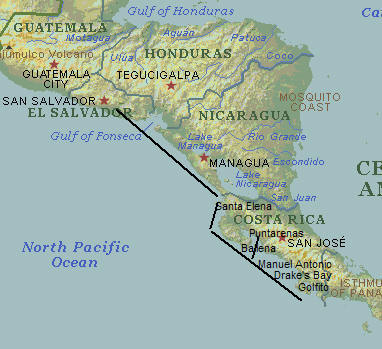 |
On the day after Thanksgiving, it was finally time to go. Although sailing superstition says one shouldn't start a long passage on a Friday, we threw caution to the wind and went for it. In order to leave Bahia del Sol, we needed to cross the sand bar at the entrance to the estuary at high tide. The bar was flat that afternoon (much calmer than our entrance), and we crossed it safely at 4:30 p.m. Three other boats crossed the bar with us; two of them stopped in Nicaragua, but our friends Pat & Carrie on Terra Firma buddy-boated with us all the way to Costa Rica. |
Passage from Bahia del Sol, El Salvador to Bahia Santa Elena, Costa Rica (11/24-26, 254 nautical miles, 43¼ hours). The potential for strong Papagallo winds along the Nicaraguan coast (occurring most frequently in the winter months) made us a bit anxious about this passage. We were especially nervous because a few days prior to our departure from Bahia del Sol, our friends Jim & Suzy on Sparta got caught in 50-knot Papagallos, were blown over 100 miles offshore and had to ride out 20-foot seas. Things went from bad to worse when their steering quadrant broke, putting a five-inch hole in their boat at the waterline. Fortunately, Jim & Suzy are very competent and resourceful, and they patched the hole and put out a sea anchor to slow their offshore drift. When the winds subsided, they rigged a temporary steering system and limped in toward the coast, and as they got closer in, the Costa Rican Coast Guard met them and towed them to port. During their ordeal, they kept in touch with the cruising community via their Single Side Band (SSB) radio. We were all quite relieved and saying a few prayers of thanks when they reached safety.
|
The problem we experienced on our passage down the coast was that we had very little wind and ended up motoring 90% of the trip. We did see 20-25 knots as we crossed the mouth of the Gulf of Fonseca (where the borders of El Salvador, Honduras and Nicaragua meet) in the middle of the night, but it was only for a few hours, and then we motored down the coast of Nicaragua in light winds. In southern Nicaragua, near San Juan del Sur, the winds finally picked up, and the last couple hours of our passage, we had an outstanding sail in about 15-20 knots of wind to our destination of Bahia Santa Elena. All during our passage, Slip Away and Terra Firma were never more than a couple miles apart, and we kept in touch on the VHF radio on a regular basis. |
|
Bahia Santa Elena, Costa Rica (11/26-30). When we arrived in Bahia Santa Elena, our friends Aly and Iain on Loon III were there waiting for us. They left Bahia del Sol about a week before us and had enjoyed some time to themselves in this beautiful anchorage. We and Terra Firma both caught a dorado on our passage, and our first night here, the six of us from the three boats shared our catches in a celebratory dinner.
Bahia Santa Elena is a very protected bay surrounded by Costa Rica's Santa Rosa National Park. We took a hike to a small waterfall and fresh water pool, explored a couple of small rivers in our dinghies and swam and relaxed after working hard the previous month and then spending two days underway. There's lots of wildlife in the Santa Rosa Park, and we especially enjoyed the wild parrots flying around and squawking away.
Bahia Murcielagos (11/30 - 18 nm, 3¼ hours). To get to Bahia Murcielagos from Bahia Santa Elena, we needed to round Punta Santa Elena, which can be a rough passage when the Papagallos are blowing. We made sure we had a good weather forecast before we left Bahia Santa Elena, and we ended up having quite a nice sail around the point in 15-20 knots of wind. It was a short trip, and since we left early in the morning, we were anchored at Murcielagos in time to have lunch and snorkel in the afternoon. Others had told us the snorkeling here was great, but for us visibility wasn't very good, but it felt good to be in the water looking at sea life. We spent one night anchored here, but we didn't sleep well because the winds were howling most of the night. The next morning, we weighed anchor around 7:30 a.m. and saw gusts to 30 knots on our wind instruments. We had to sail through a fairly narrow passage between some islands, and the winds were shifting about from a couple of directions, so we kept our engine running and powered through it. Once we got through the island passage, we set our sails and had an outstanding sail across the Golfo de Papagallo to Bahia Huevos.
|
Bahia Huevos (12/1-4 - 22.6 nm, 4¾ hours). As
we started our sail across the Golfo de Papagallo, we were beam reaching in 20 knots of wind, with gusts to 25. However,
as we continued southeast to Bahia Huevos, winds got lighter and lighter.
We started out with a double-reefed main and a partially reefed headsail.
As the winds lightened, we unrolled the headsail, shook the reefs out of the
main, then hoisted our mizzen. A half hour before we reached our
destination, the winds died to almost nothing, and we doused our sails,
started the engine, and motored into the anchorage.
We spent three days in Bahia Huevos (still traveling with Loon III and Terra Firma), and we count this among one of our favorite anchorages in Costa Rica. We snorkeled here, and again visibility wasn't great, but we did see some large stingrays, a spotted eagle ray and a shark sleeping near some rocks. Our favorite part of this anchorage was the river trip we did in our dinghy. We motored up the river at high tide, and then drifted down the river as the tide ebbed. The bird life was incredible on this trip, and the parrots made quite a ruckus. Unfortunately, we usually couldn't see the parrots because they were green parrots and blended quite well with the foliage. At one point, the parrots were squawking up a storm, and we couldn't see them, and a very frustrated Iain stood up in his dinghy and demanded "Show yourselves!!" The rest of us were cracking up. After the river trip, Pat & Carrie and Iain & Aly helped us celebrate Jan's birthday. The "Loonies" baked a cake and made her a very special hat, and Terra Firma brought some wine. That evening, we ate cake, drank the wine and played Dominoes. It was a great celebration. |
|
Playa del Coco (12/4-5 - 6.8 nm, 1½ hours). Playa del Coco is no great shakes, but we needed to stop here because it was our port of entry into Costa Rica, and we had to check-in with the authorities. There's also a good grocery store here, and we were all eager to pick up some fresh produce. We completed our check-in, enjoyed a nice lunch on shore and grocery shopped - all in one day! Although that might not sound like much to folks who live on land ("dirt dwellers," as Rich calls you), this was quite an accomplishment for a group of cruisers traveling in Latin America.
We spent one night in the Playa del Coco anchorage and went back ashore the next morning for breakfast at a restaurant with wireless internet. While eating breakfast and checking email, we felt an earthquake - something we hadn't experienced since leaving California. It wasn't a big one, but everyone in the restaurant felt it. After breakfast, we continued on to Bahia Guacamaya, a short distance away.
Bahia Guacamaya (12/5-7 - 8.5 nm, 2 hours). Winds were picking up as we weighed anchor at Playa del Coco, and it was a rollicking sail to Bahia Guacamaya. The Loon's had gone ahead earlier that day and were already anchored in Guacamaya; we traveled in company with Terra Firma on this passage. We saw winds up to 28 knots, and seas were 4-6 feet on our beam, which made it an uncomfortable trip. This wasn't one of our better passages - perhaps we had gotten overconfident and did not anticipate how rough this passage would be, and we made a few mistakes along the way. After we finally got our anchor set, Rich spent about 30 minutes sitting on the cabin top and "decompressing." Fortunately none of our mistakes cost us anything but a little pride. Later, when talking with Terra Firma, they told us that they, too, had a few screw ups along the way. We were all quite happy to stay anchored in the shelter of this bay for a couple nights.
Bahia Ballena (12/7-10 - 106 nm, 24 hours). We had some good wind at the beginning of our passage from Guacamaya to Ballena and sailed wing-and-wing for several hours. As we got closer to Ballena, we were getting out of the Papagallo region, and the winds decreased significantly. We had absolutely no wind for the last several miles of the passage, and motored into the Golfo de Nicoya with flat glassy seas. The Gulf of Nicoya is a large body of water fed by a number of rivers, and we were amazed to see several trees floating in the water as we motored along. We really had to keep a close watch, as we didn't want to run into one of those! We anchored on the north side of Bahia Ballena, where the water was nice for swimming, although the anchorage was a bit rolly.
| At the south side of Ballena Bay, there is a big dock which serves the local fisherman, and we were able to tie our dinghies there, but the dock is fixed (not floating), and the bay has big tides (over 8 feet), so climbing out of the dinghy at low tide was a challenge. The Ballena Bay Yacht Club sits adjacent to the dock, and one Saturday, we shopped at their organic vegetable market, went for a walk around the area, and then came back to the Yacht Club for hamburgers and fries. While at the Yacht Club, we met Honey Heart. She and her husband are old hippies who sailed to Costa Rica years ago, raised their family here in this bay and developed the Heart Inverter, which many boaters use to convert 12 volt electricity to 110. Honey is quite a character and has lots of stories to tell, and we enjoyed talking with her for a while. |
|
When we arrived in Ballena Bay, friends on Hurrah (Barb & Gary) and Sea Bird (Stan & Meghan) were already anchored here. We hadn't seen these folks since Huatulco, so it was nice to run into them again, and on Saturday evening, Terra Firma invited all of us to happy hour on their boat. The Loons arrived on Saturday afternoon and caught a couple of dorado on the way, and they gave one of them to us to share with Terra Firma. Rich agreed to clean the fish, and we asked Carrie if she would make ceviche for happy hour because Carrie makes the BEST ceviche. That evening, after the party on Terra Firma, Jan went to bed not feeling well, and the next morning, Rich told her that he had gotten sick during the night. When Jan was talking to Loon and Terra Firma on the radio the next morning, she asked if any of them had gotten sick, and the answer was "affirmative." All of us who ate ceviche had gotten sick, with the exception of Gary on Hurrah, who must have an incredible cast iron stomach! Fortunately, the illness passed quickly, and although she was not responsible, Carrie felt badly, and she bore the brunt of much teasing for weeks afterward. Rich said he noticed the flesh of the fish felt different when he cleaned it. And, the Loons caught the fish, so it was a team effort.
Isla San Lucas, Golfo de Nicoya (12/10-11 - 27 nm, 4½ hours). From Ballena Bay, we continued further up into the Gulf of Nicoya. We were working our way toward Puntarenas because from there, we wanted to take an inland trip to the Monteverde Cloud Forest. There are a number of islands dotting this gulf, and the scenery is quite beautiful, but the water was murky and not really appealing for swimming. We anchored one evening at Isla San Lucas. The anchorage was very calm (a nice change from rolly Bahia Ballena), and we especially enjoyed listening to the howler monkeys here. We'd heard them at a number of the previous anchorages, but there were more of them here, and they felt really close by.
Puntarenas, Golfo de Nicoya (12/11-20). The entrance to the Port of Puntarenas was just a couple of miles from Isla San Lucas. We arrived early in the morning, and a panga from the Costa Rica Yacht Club met us at the port entrance to lead us up an estuary to their facilities. We arrived at high tide because some places along the way were very shallow and impassable when the tide is low. We would be leaving Slip Away at the Costa Rica Yacht Club while we traveled inland to Monteverde.
After returning from Monteverde, and before leaving the Costa Rica Yacht Club, we spent a couple days doing some errands and chores - provisioning (great jumbo shrimp here!) laundry, filling up on diesel, a haircut for Jan, and washing Slip Away from bow to stern. We were moored to a floating "docklet" which had running water on it, a luxury we had not had for over seven months. (Fortunately, the rainy season helped to keep Slip Away from becoming totally covered in dirt.) It was nice to have the opportunity to clear her decks and scrub her down with soap and water. Slip Away was sparkling when we departed Puntarenas.
Manuel Antonio Park (12/21-22 - 68 nm, 16 hours). We left the Costa Rica Yacht Club at high tide in the late afternoon and thought we'd take advantage of the push from the current as the tide ebbed and we cruised down the Gulf of Nicoya. As we exited the estuary and entered the gulf, we had 12-13 knots of wind on our nose. Since the wind was opposing the current, it made for very choppy seas, and in short order, Slip Away hit a few waves that sent salt spray all over her clean exterior. Bummer! In hindsight, with these conditions, we probably should have pulled into an anchorage at one of the islands, spent the night and left in the morning when the winds were calmer. However, we were eager to get to Manuel Antonio Park, where we wanted to spend a couple of days before meeting up with friends for Christmas. So we pushed on. Something else we should have paid more attention to was the weather. It was cloudier than normal, and it looked like it was going to rain. And it did - it poured for several hours. On the bright side, the rain washed all the salt spray off Slip Away, and there was no lightning or high winds. However, it's not very much fun to do an overnight passage in the pouring rain. But we motored through it and arrived Manuel Antonio Park early the next morning with no real problems.
We wanted to visit Manuel Antonio because we'd heard there were some great hikes here, with lots of potential wildlife sightings. The anchorage at Manuel Antonio was probably the prettiest one we visited in Costa Rica; however, the timing wasn't right for us. There was a fairly large swell coming into the anchorage, and landing the dinghy on the beach looked pretty treacherous. (Surfboards would have been more useful!) All we could do was enjoy the view from the boat. The swell also made the anchorage rolly and uncomfortable, so we left early the next morning.
Drake's Bay (12/22-26 - 50.8 nm, 9 hours). We were planning to meet friends in Drake's Bay for Christmas, and since that was just a few days away, we headed there from Manuel Antonio. We had no wind on this passage, so we motored the whole way. We'd heard reports that Drake's Bay can sometimes be rolly, but it was nice and calm during our stay. Most of the group we were meeting for Christmas were a day or two behind us, but a few hours after we set our anchor, our friends Steve & Susan on Last Resort showed up. They left El Salvador a couple of weeks after us, but they skipped some of the middle portion of Costa Rica and caught up with us. It was really great to see them! Steve's birthday was the previous day, and they invited us over to their boat to celebrate. They caught a dorado along the way and shared it with us, and Susan had also baked a coconut cream pie (quite an accomplishment because they'd had some rough seas). It was a fun reunion and celebration.
The next day, Susan and Jan went ashore for a walk and to check out the area. Bahia Drake is in close proximity to Costa Rica's Corcovado National Park, but it's a fairly remote area and difficult to get to. There were a couple of small hotels and shops and a tour operator ashore. Corcovado Park was far enough away that the only way to really see it from here was to take a tour, but the tours were pretty expensive, and since we had just visited Monteverde, we decided to pass. This area is home to Costa Rica's largest population of scarlet macaws, and while ashore, Susan and Jan spotted a couple of them flying around.
|
Over the next couple of days, four more boats of friends showed up at Bahia Drake, and twelve of us celebrated Christmas together - Steve & Susan from Last Resort, Pat & Carrie from Terra Firma, Iain & Aly from Loon III, Gary & Celeste from Sol Surfin', Marc & Laura from Paladin, and us. Fortunately, one of the boats - Sol Surfin' - is a spacious catamaran and could comfortably accommodate all of us. We shared a potluck dinner and had a fun gift exchange, in which we stole each others' presents. The gifts were a variety of items - books, a can of bug spray, a hand-made beaded item, a DVD, CD's, a large funnel and a blow-up airline neck pillow (which the guys seemed to think was a hemorrhoid pillow and stole from each other a number of times!). It was required that all gifts be wrapped for this exchange, and since none of us stock wrapping paper on our boats, it was fun to see the clever ideas for it - from magazine pages to aluminum foil, plastic grocery bags and old nautical charts. Susan, Aly and Jan baked some traditional Christmas treats, which we shared with all. It was a very special celebration. |
|
Passage to Golfito (12/26-27- 68 nm, 14 1/2 hours). We left Bahia Drake the day after Christmas, along with Last Resort and Terra Firma, for an overnight passage to Golfito, which would be our last port of call in Costa Rica. We left in the late afternoon, and about 1½ hours into our passage, a boat gremlin struck. Rich noticed an error light on our inverter and looked in the engine room to find that a hose clamp had broken on an anti-siphon valve, and salt water was spewing all over our engine room. We stopped the engine, and Rich made the repair, but the salt water wreaked havoc on a few things. After we got underway again, and the engine was running, we both noticed a burning smell. Rich tracked it down to the generator - apparently salt water got into the starter, which was burning itself out trying to turn over. He was able to turn a battery switch so the generator starter would have no power to it, and the smell dissipated. We continued underway knowing we'd have some repairs to make when we got to Golfito and praying that the damage would not be too extensive. The rest of the trip passed with less excitement - just a few rain showers and dodging some fishing boats as we arrived in the Golfo Dulce.
Golfito (12/27-1/4). Golfito was once a bustling banana-exporting port, and for many years, it was the headquarters of United Fruit Company. However, a combination of factors - declining foreign markets, rising export taxes, worker unrest and banana diseases - led to the decline of that industry, and United Fruit closed its operations here in 1985. United Fruit constructed a lot of buildings in this town, and many of them still stand, some used for other purposes now, and some in disrepair. We'd heard Golfito described as "a nice town gone shabby," so we were prepared not to like it, but we were pleasantly surprised. We took at mooring ball at Land & Sea, a small business operated by a couple of Americans (Tim & Katy) who moved to Costa Rica several years back. They had a nice dinghy dock and a building that we'd describe as a "clubhouse," with a wonderful porch, a TV room, great showers, a fridge stocked with cold beer and soda ($1 each - write your name on a whiteboard, keep track and pay when you leave), four friendly dogs and four mostly-friendly cats. It was a comfortable spot to hang out for a week while we cleaned up the mess in our engine room, and at $5/day, it was probably the best bargain we've ever found.
| Rich bore the brunt of sorting things out in the engine room, but our friends Pat & Carrie on Terra Firma are both electrical engineers and helped him clean the salt water out of our inverter. After an initial hiccup, it appears to be working fine (knock on wood!) Fortunately, we had a spare starter for the generator, and replacing the burned-up one solved that problem. The salt water also shorted out our fresh water pump - the one that feeds the faucets throughout the boat - but luckily we also had a spare for that. After making those repairs, Rich spent a couple of days just cleaning up the salt. He also checked all other hose clamps in the engine room and replaced a few that looked like they could be failing. (Because of our experience, Pat on Terra Firma also checked all of his hose clamps and found a few that he replaced, too.) |
|
While in Golfito, we had one more December birthday to celebrate. Carrie on Terra Firma turned 39 (again) on the 27th of December. (Actually, we're all jealous of Carrie because she's turned 39 a lot less often than the rest of us!) We found a good Chinese restaurant for a birthday dinner party. We also celebrated a relatively quiet New Year's Eve at the Land & Sea "clubhouse." We always refer to 9 p.m. as "cruiser midnight", so we popped the corks on the champagne at 9, and were back on our respective boats by the local midnight.
From Golfito, we would be heading to the cruising grounds of Western Panama (mostly remote islands), so we needed to stock up on provisions as much as possible. Because we were here during the holidays, grocery store stocks on some items were slim pickings, but we bought what we could find. One of the bonuses of a stop in Golfito is their Free-Trade Zone. After the demise of the banana export business, in order to revitalize the local economy, the government established this zone, which is similar to a duty-free store at an airport - wines, liquors and perfumes sold at a discount, but here they also sell other items like appliances and tires. The Free-Trade Zone had great prices on Flor de Caña Rum and wines, so we bought a bunch (but, Pat & Carrie on Terra Firma bought more!)
Before leaving Golfito, we needed to "check out" of the country, which meant visits to the Port Captain, Immigration and Customs. On January 3, we made the required rounds with officials and on the 4th, we set sail for Panama.
Our Impressions of Cruising in Costa Rica
There are some things we really liked about Costa Rica - pretty anchorages surrounded by lush green vegetation, lots of wildlife, great bird songs and squawks, and howler monkeys calling to one another in the mornings and evenings. Costa Rica has some beautiful National Parks. With the exception of Puntarenas and the Gulf of Nicoya, the water was clean, warm and good for swimming (although not a lot of great snorkeling). Another bonus about Costa Rica is that one can drink the tap water there. Since we were having problems with our watermaker, it was nice to be able to fill up our tanks with local water. Costa Rica has good grocery stores for provisioning, but in general, we found the prices to be a bit high. A number of North Americans and Europeans have relocated to Costa Rica, so this country has a different feel to it than other Central American countries, and we found the local people here to be less friendly.
Unfortunately, Costa Rica also has a problem with crime, mostly theft. We know of several cruisers who had their dinghies and/or outboards stolen in Costa Rica. The problem was especially prevalent in the Gulf of Nicoya (Puntarenas) and Golfito. When we went to Monteverde, we put our outboard in the cockpit (out of sight) and locked it to the steering pedestal. We also know of two boats who were awoken in the middle of the night by bandits who boarded their boats. Fortunately, in both instances, the cruisers scared off the intruders before they stole anything, and we did not hear of any instances of attacks on persons. If the incidents of theft were uncommon, it would not have concerned us so much, but they happened too often. Having already experienced the theft of some items from Slip Away in Mexico, we were not eager to do it again. We made it through Costa Rica unscathed, but the concern about it nagged at us and detracted from our enjoyment of this country.
Prior to coming to Costa Rica, we'd read an email from another cruiser who said, "Don't skip Costa Rica, but don't spend forever there." That pretty much sums it up for us, too.
